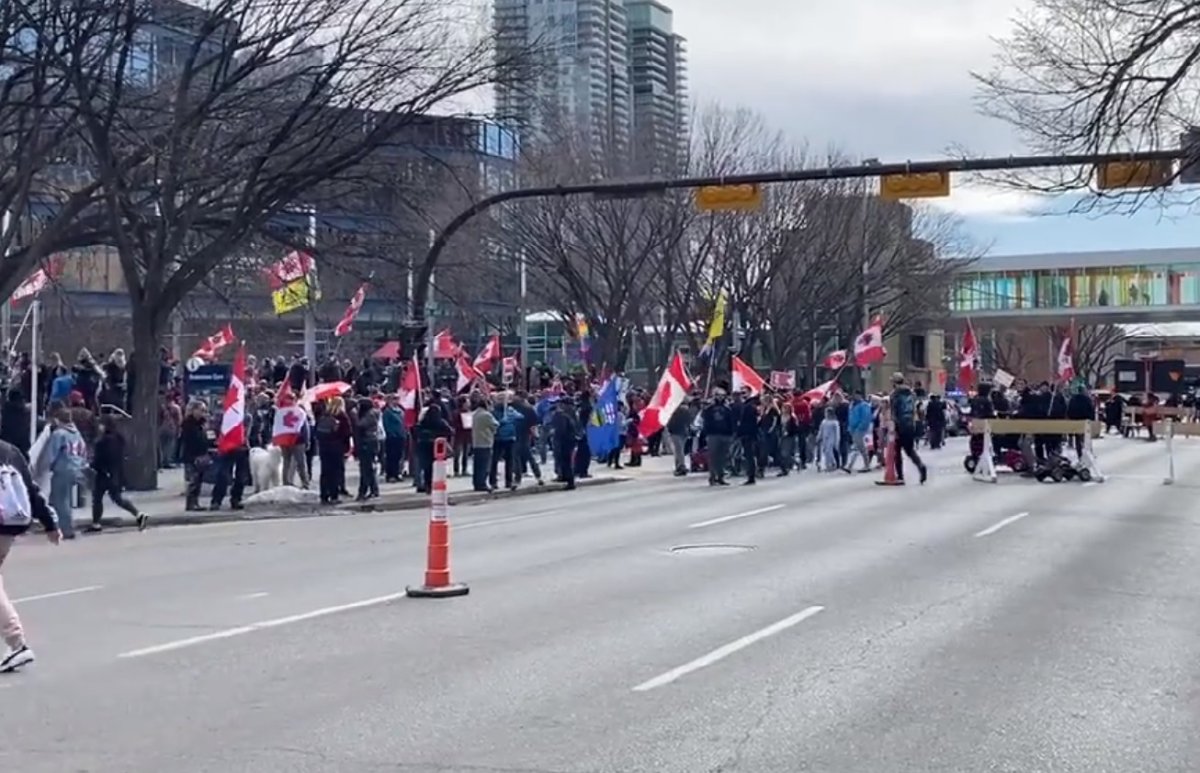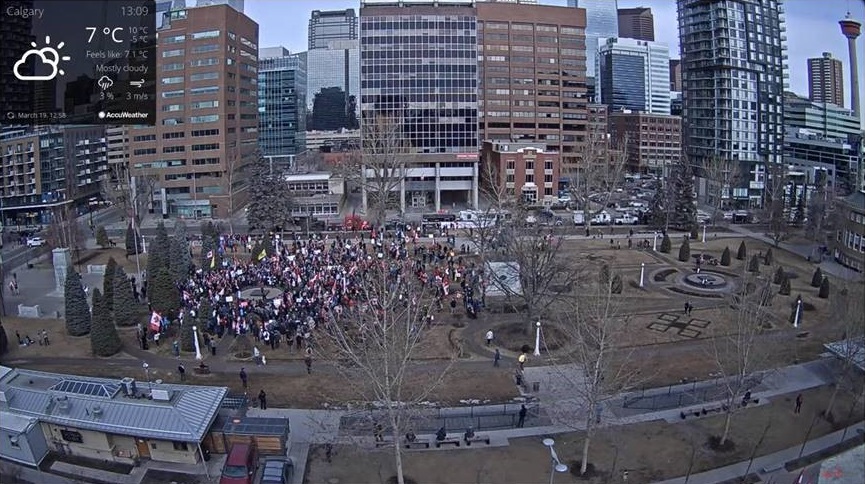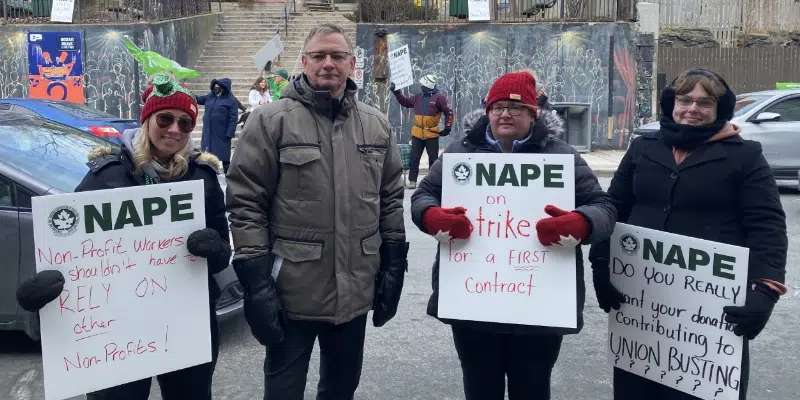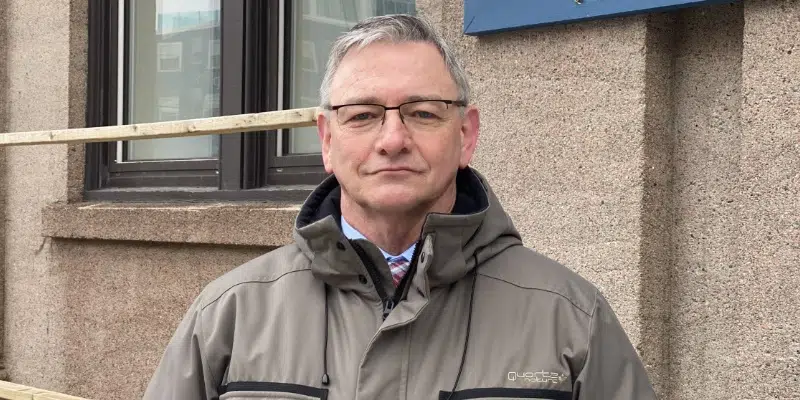POST CONVOY PROTESTS CONTINUE
Court grants immediate injunction on Beltline protests in Calgary against public health
Police say intelligence indicates there may be an imminent
public safety risk
The City of Calgary has been granted a temporary court injunction to help address protests in the city's Beltline area against public health measures.
An Alberta Court of Queen's Bench justice granted an immediate injunction that will address protests in the Beltline and elsewhere in Calgary, the city said in an emailed statement.
The injunction prohibits ongoing violations of existing bylaws and legislation, and reinforces and clarifies enforcement authority.
The injunction prohibits blocking traffic on roads and sidewalks, walking in the middle of roadways, preventing vehicles and pedestrians from lawfully passing by or accessing amenities in the area, without authorization or permit.
It also prohibits conducting activity in a park that unreasonably disturbs the use or enjoyment of the park for other users of the park, or hosting an event or using an amplification system in a park without a permit, and commercial activity within a park. It also applies to the unnecessary sounding of horns or other audible warning devices.
However, community protests and events are still allowed to occur if they comply with bylaw requirements and secure appropriate permits, the city said.
Read the temporary court injunction:
(PDF KB)
(Text KB)CBC is not responsible for 3rd party content
Police aware of protesters with links to white supremacy groups
"There will be no marching tomorrow, there will be no mobile protest, and there will be nobody behaving that way down in the Beltline," police Chief Mark Neufeld said Friday during a special meeting between the Calgary Police Service and the Calgary Police Commission.
The injunction means that instead of officers doing bylaw enforcement, which would result in a ticket, if police see anyone doing any of the actions prohibited by the injunction, the offenders could go "directly to jail," Neufeld said.
Earlier this week, the police comission said ticketing organizers and attendees has proven "ineffective" in prior anti-mandate protests.
Police also warned the public that their intelligence indicates there may be an imminent public safety risk at future demonstrations. Neufeld also said they are aware that there have been protesters with links to white supremacist groups.
Police say the protest size has changed over recent months. In the beginning of 2022, there were about 300 people attending protests. In February, that number grew to between 2,000 and 5,000. At the end of February and early March, there were 1,300.
Protesters, counter-protesters say they're going ahead
Protests in Calgary against COVID-19 public health restrictions started nearly two years ago.
They have continued in the Beltline and Central Memorial Park each week, despite the fact that most of the province's mandates have been lifted. In recent weeks, counter-protesters have started demonstrating in the area at the same time.
Community Solidarity YYC, which has represented counter-protesters in the Beltline, tweeted that the group plans to peacefully assemble.
Jake Eskesen, who has been attending Beltline protests, said in an email to CBC that anti-mandate protesters will not be deterred by the injunction.
'There are consequences for breaking the law'
"[This] now is a really important warning shot to the people who are engaged in these kinds of protests that there are legal consequences for what's happening," said Doug King, professor of justice studies at Mount Royal University.
"There are consequences for breaking the law while engaged in a peaceful protest."
Violating a court order is a Criminal Code offence, King said, which could lead to six months incarceration, plus the potential of a $5,000 fine.
King, who lives near the area, said that since the Coutts border blockade and simultaneous protests in Ottawa, the Beltline demonstrations have become increasingly aggressive.
Police chief says he has regrets
Police commission chair Shawn Cornett said work will ramp up after this weekend: "We need to look at what has gone on, what we've done, have we been doing the things that we needed to do? There's lots of discussions to happen."
In an column penned by Neufeld for the Calgary Herald, the police chief said he regrets that "we find ourselves in a place where Beltline residents feel unsafe and unsupported in their community."
"I also regret that despite ongoing efforts to come to a diplomatic resolution with some protest groups — something we have done for years in our city — we are now in a place where this situation must be resolved in less subtle ways," Neufeld wrote.
Neighbourhood association pleased with injunction
The Beltline Neighbourhoods Association said they are pleased to see the temporary court injunction as a tool to help Calgary law enforcement respond to the demonstrations.
"We are hopeful that this allows our community to return to being the vibrant, safe, and welcoming place it was before these aggressive demonstrations."
With files from Colleen Underwood
Freedom protest moved to city hall, police monitor situation at Calgary park
Michael Franklin
CTVNewsCalgary.ca Senior Digital Producer
Published March 19, 2022
A mass protest scheduled to take place in Calgary's Central Memorial Park on Saturday has moved out of the neighbourhood, resettling on the steps of Calgary city hall.
The rally, organized by a group calling itself Calgary Freedom Central, was supposed to take place at the park at 1 p.m., but CTV News crews found the gathering that had met in the park for the past several weekend never materialized there.
Instead, it took place outside city hall, where people waved flags and listened to speakers as police looked on.
It was a massive show of force from the Calgary Police Service, however, as hundreds of members were mobilized at the scene to keep the peace.
A group of counter-protesters, made up of Beltline residents who were tired of the ongoing demonstrations, also showed up at the scene, but they marched to Central Memorial Park.
Once there, they engaged with a handful of freedom protesters while police stood between them.
COURT INJUNCTION
The change in tone comes after a temporary court injunction was granted Friday and a resolution from the Calgary Police Service that says it will enforce those rules.
Following a meeting of the Calgary Police Commission, Chief Mark Neufeld said "there will be no marching" on Saturday.
"Residents will see a significant police presence," he said Friday afternoon.
"There will be nobody behaving that way on the Beltline."
The order says that anyone who blocks roads or sidewalks could be charged and potentially arrested.
The same threat applies to anyone accused of excessive noise or conducting commercial activity in parks without proper permits.
The rules come after a group of Beltline residents, fed up with the weeks of freedom rallies in their communities, organized a counter-protest on March 12 that turned ugly.
The freedom protesters, who had long fought against the COVID-19 public health restrictions imposed on Albertans and Canadians, also seemed to sing a different tune during this latest protest.
Instead of speaking about the unfairness of restrictions, many of them turned their attention back to Prime Minister Justin Trudeau and his Liberal government.
Last week, Premier Jason Kenney called out the protesters for their criticism of COVID-19 rules even though Alberta had virtually none to speak of.
"I would suggest that maybe people could find more productive ways of expressing their frustration, but maybe here’s an idea – how about we all just move on from the frustration of COVID?" said Kenney last week.
"How about we leave it in the rear view mirror?"
‘Several arrests’ as protestors and counter-protesters meet in Beltine District
Protesters and counter-protesters gathered in the Beltline district Saturday for the first time since the city was granted an emergency injunction.

About 350 people gathered around 1 p.m. at Central Memorial Park in protest of medical mandates across Canada. After some speeches, the crowd — known as Group A in Calgary police tweets — began to move, making their way to city hall, a few blocks away.
Police told Global News at that point the protesters were not in violation of an emergency injunction put in place Friday afternoon, because they were staying on the sidewalk.
Around 2 p.m., police tweeted, saying Macleod Trail would be temporarily closed in front of Municipal Plaza to allow for crowds to cross safely.
Minutes later, CPS said the group had breached the injunction when they obstructed the roadway. As of 2:19 p.m. police said they had cleared the roadway and traffic was moving again.
Dustin Nolan was among those who joined the anti-mandate protest. He said he felt compelled to show up.
“I think it’s very sad, because we have the right as Canadians to peacefully protest and gather like this and express our feelings and our thoughts towards everything, so the fact that they are trying to tell us we can’t is wrong,” Nolan said.
“I just think it’s wrong what the government is doing mandating vaccines. I can’t get on a plane to go see my family across Canada right now. It’s hard. I’d like to go visit people and travel and I can’t just because of my views.”
“I realize there are some people here with some strange views that I don’t agree with,” said Doug Tweet, another protester who gathered at CMP/city hall.
“There’s lots of conspiracy theories which I don’t agree with but I just agree with freedom.”
Counter protesters had gathered at nearby Lougheed House, but some made their way to Central Memorial Park, where police worked to keep the two sides apart.
Around 4 p.m., police said they made several arrests. Details are expected to be released later.
Continued protests
Anti-mandate demonstrations have been held weekly at Central Memorial Park, typically followed by a march down 17th Avenue.
Last weekend, area residents and others tried to “take back the community” and the two groups clashed in what police saw as a public safety issue. Police were seen in online videos physically moving some of the residents using their service bikes.
The situation led to an outcry from residents, a special city council meeting, a letter to the police commission from the mayor and, finally, an emergency injunction by the city on Friday afternoon.
Calgary Mayor Jyoti Gondek said on Twitter last weekend that the disruption, which she called a parade and festival without proper permits and licences, needed enforcement by police rather than crowd control.
READ MORE: Calgary mayor calling for police enforcement against continued COVID restriction protests
“This was a damned if you do and damned if don’t, no-win for the police,” police Chief Mark Neufeld said Monday.
The injunction strengthens police authority to enforce the law.
“This is the exact tool we need as we all work together to return a sense of normalcy to the Beltline community,” Neufeld said in a news release Friday.
Both city council and the police commission have said they received hundreds of emails and phone calls from Calgarians about the protests in recent weeks.
A letter to the police commission from the mayor laid out some of those concerns.
“The level of noise from protester’s vehicle horns and chanting is negatively impacting quality of life,” Gondek wrote.
She noted residents, many of whom live in one- or two-bedroom condos or apartments, have been leaving the area to avoid feeling trapped in their homes on Saturday afternoons. Others have reported being harassed for wearing masks.
Businesses have reported lost income as customers flee the area before the protests begin.
— with files from The Canadian Press
CALGARY — Police arrested several people at a so-called freedom protest in downtown Calgary on Saturday after some demonstrators refused to leave a park that has become ground zero in the city for the weekly rallies.
Calgary Police Service Chief Mark Neufeld said five people were charged with breaching an injunction, with one of them facing an additional charge of assaulting a police officer. And a sixth person was arrested on an outstanding warrant.
"These efforts will continue as we work together to bring peace back to the Beltline and the surrounding communities here in Calgary," Neufeld told a news conference just after suppertime.
By then, the park had emptied and few police remained on the scene.
"This was not an issue that developed in one day or one weekend and it's not one that's going to be completely resolved in one day or one weekend," Neufeld said, adding additional charges are expected.
One man was taken to the ground by multiple officers shortly after mounted units and police with bicycles began pushing people to the outskirts of Central Memorial Park in the Beltline neighbourhood.
Another man sat on a park bench and refused to leave. He was handcuffed in front of a crowd of hundreds with many holding signs against COVID-19 health measures.
Earlier, a group of about 1,000 people converged at the park before taking the protest to city hall. Police forced demonstrators back from roadways so traffic could move.
"They can't stop us," said a speaker over a megaphone.
Another said, "They're not going to scare me away. I am not fearful just like you are not fearful. Keep standing up."
Some people waved upside-down Canadian flags, Alberta flags and at least one Gadsden flag — a yellow banner with a snake reading "don't tread on me," which is sometimes used in support of far-right ideology.
Others carried signs that read "Freedom not Farce" and "No Mask or Vax Mandates."
Hours later, a portion of the group marched to the park where they were met with heavy police enforcement.
The group has typically marched down 17th Avenue, a popular street with restaurants, bars and stores. Last weekend, local residents clashed with protesters there in what police described as a public safety issue.
The ongoing weekend protests have led to an outcry from residents, a special city council meeting, a letter to the police commission from the mayor and an emergency injunction by the city on Friday.
The injunction strengthens police authority to enforce the law.
Premier Jason Kenney was asked to comment on the protests earlier Saturday while on his new weekly phone-in radio show on CHQR and CHED.
He said he didn't know why there were still protests, because Alberta removed its COVID-19 restrictions weeks ago.
Kenney suggested people could instead demonstrate at McDougall Centre, the provincial government's offices in Calgary, or the Harry Hays building, where the federal government offices are located.
"If you're upset about the federal travel vaccine mandates — so am I — go in front of there," he said. "You can make your point without inconveniencing people in that neighbourhood."
Both city council and the police commission have said they received hundreds of emails and phone calls from Calgarians about the protests in recent weeks.
The letter to the police commission from Mayor Jyoti Gondek laid out some of those concerns.
"The level of noise from protester's vehicle horns and chanting is negatively impacting quality of life," she wrote.
Gondek noted residents, many of whom live in one- or two-bedroom condos or apartments, have been leaving the area to avoid feeling trapped in their homes on Saturday afternoons. Others have reported being harassed for wearing masks.
Businesses have reported lost income as customers have been leaving the area before the protests begin.
Dan Murray, who owns I Love You Coffee Shop in the Beltline, said the protests started about 18 months ago and grew "worse and worse" after truckers took over Canada's capital city.
The demonstration at Parliament Hill lasted about three weeks until Prime Minister Justin Trudeau invoked the federal Emergencies Act. More than 100 people were charged with various offences between Feb. 17 and 18.
Peter Oliver, president of the Beltline Neighbourhoods Association, said the protests have turned into a "real toxic mix" that include white supremacists and other extremists.
"We have a serious problem here," he said earlier this week.
"It's a whole buffet of different losers."
— With files from Rob Drinkwater in Edmonton.
This report by The Canadian Press was first published on March 19, 2022.
Alanna Smith and Colette Derworiz, The Canadian Press
Beltline protests spur special Calgary Police Commission meeting
Calgary police implores protesters to 'stay away' from the Beltline on Saturday
Calgary police chief addresses use of force at weekend protest
Freedom protest disturbing more than just the peace, Calgary mayor says
'Leave us alone': Beltline residents beg protesters to stop disrupting their community
















